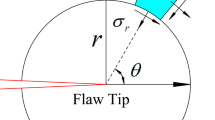Abstract
Previous tests have shown that the mode II and mode III fracture energies of adhesive bonds coincide, with the nominal value dictated by post-yield shear deformation in the interlayer. This suggests that the complete mixed-mode fracture behavior may be dellineated by determining the interaction curve in either theG I -G II orG I -G III plane. A DCB-type specimen capable of delivering the entire opening versus shearing toughness spectrum in a single test was used. A brittle and a ductile epoxy resin were evaluated, with the adhesive thickness varying from a few micrometers up to 0.6 mm. Excluding very thin bonds, the mixed-mode fracture curve was approximately bilinear; when the applied energy release rate in shear,G s , was relatively small, the total fracture energy equaledG IC but otherwise, the fracture curve decreased essentially linearly with increasingG S . In the case of the ductile adhesive, the transition in trends occurred whenG S was approximately 55 percent of the shearing fracture energy. When the bond thickness was decreased to a few micrometers, the mixed-mode curve displayed a concave shape, with mode interaction occurring promptly. SEM analysis and analytical considerations suggest that this change in mixed-mode behavior was due to the development of a triaxial state of stress in the interlayer. Based on previous fracture studies of the individual fracture modes in adhesive bonds and laminated composites, the present results should be also applicable to mixed-mode interlaminar fracture of laminated composites.
Similar content being viewed by others
References
Wu, E.M., “Application of Fracture Mechanics to Anisotropic Plates,” J. Appl. Mech., 967–974 (1967).
Berglund, L. and Johannesson, T., “Mixed-Mode Fracture of PEEK/Carbon Fiber Composites,” Proc. ECCM-1, Bordeaux, France, 259–264 (1985).
Reeder, J.R. andCrews, J.H. Jr., “Mixed-Mode Bending Method for Delamination Testing,”AIAA J.,28,1270–1276 (1990).
Yoon, S.H. and Hong, C.S., “Interlaminar Fracture Toughness of Graphite/Epoxy Composite Under Mixed-mode Deformations,” Experimental Mechanics,234–239 (1990).
Yoon, S.H. andHong, C.S., “Modified End Notched Flexure Specimen for Mixed Mode Interlaminar Fracture in Laminated Composites,”Int. J. Fract.,43,R3-R9 (1990).
Hashemi, S., Kinloch, A.J. andWilliams, J.G., “The Effects of Geometry, Rate and Temperature on the Mode I, Mode II and Mixed-Mode I/II Interlaminar Fracture of Carbon-Fibre/Poly(ether-ether ketone) Composites,”J. Comp. Mat.,24,918–956 (1990).
Chai, H., “On the Correlation Between the Mode I Failure of Adhesive Joints and Laminated Composites,”Eng. Fract. Mech.,24,413–431 (1986).
Johnson, W.S. andMangalgiri, P.D., “Investigation of Fiber Bridging in Double Cantilever Beam Specimens,”J. Comp. Tech. & Res.,9,10–13 (Spring1987).
Sidey, G.R. and Bradshaw, F.J., “Some Investigations on Carbon-Fibre-Reinforced Plastics Under Impact Loading, and Measurements of Fracture Energies,” Carbon Fibers, Their Composites and Applications, Proc. Int. Conf. of the Plastic Institute, London, 208–213 (1971).
Chai, H., “Interlaminar Shear Fracture of Laminated Composites,”Int. J. Fract.,43,117–131 (1990).
Martin, R.H., “Evaluation of the Split Cantilever Beam for Mode III Delamination Testing,” Composite Materials: Fatigue and Fracture, ed. T.K. O'Brien, ASTM STP 1110, 243–266 (1991).
Chai, H., “Shear Fracture,”Int. J. Fract.,37,137–159 (1988).
Bradley, W.L., “The Role of Matrix Properties on the Toughness of Thermoplastic Composites,” Thermoplastic Composite Materials, ed. R. Byron Pypes, Elsevier Science Publishers (1989).
Chai, H., “Micromechanics of Shear Deformation in Cracked Bonded Joints,” Int. J. Fract., in press.
Trantina, G.G., “Combined Mode Crack Extension in Adhesive Joints,”J. Comp. Mat.,6,371–384 (1972).
Bascom, W.D. andOroshnik, J., “The Effect of Bond Angle on Mixed-Mode Adhesive Fracture,”J. Mat. Sci.,13,1411–1418 (1978).
Wang, J.S. and Suo, Z., “Experimental Determination of Interfacial Toughness Curves Using Brazil-Nut-Sandwiches,” Acta Met. (in press).
Cao, H.C. andEvans, A.G., “An Experimental Study of the Fracture Resistance of Bimaterial Interfaces,”Mech. of Mat.,7,295–304 (1989).
Thouless, M.D., “Fracture of a Model Interface Under Mixed-Mode Loading,”Acta Met.,38,1135–1140 (1990).
Liechti, K.M. andFreda, T., “On the Use of Laminated Beams for the Determination of Pure and Mixed-Mode Fracture Properties of Structural Adhesives,”J. Adhesion,29,145–169 (1989).
Chai, H., “Fracture Work of Thin Bondline Adhesive Joints,”J. Mat. Sci. Lett.,7,399–401 (1988).
Chai, H., “Deformation and Failure of Adhesive Bonds Under Shear Loading,” J. Mat. Sci., in press.
Berry, J.P., “Determination of Fracture Surface Energies by the Cleavage Technique,”J. Appl. Phys. 34,62 (1963).
Naik, A.R., Crews, J.H. and Shivakumar, K.N., “Effect of T-Tabs and Large Deflection in Double Cantilever Beam Specimen Tests,” ed. T.K. O'Brien, ASTM STP 1110, 169–186 (1991).
Chai, H., “Bond Thickness Effect in Adhesive Joints and Its Significance for Mode I Interlaminar Fracture of Composites,” Composite Materials: Testing and Design (Seventh Conference), ed. J.M. Whitney, ASTM STP 893, 209–231 (1986).
Author information
Authors and Affiliations
Additional information
Herzl Chai, formerly associated with Polymers Division, Materials Science and Engineering Laboratory, National Institute of Standards and Technology, Gaithersburg, MD 20899
Rights and permissions
About this article
Cite this article
Chai, H. Experimental evaluation of mixed-mode fracture in adhesive bonds. Experimental Mechanics 32, 296–303 (1992). https://doi.org/10.1007/BF02325581
Received:
Revised:
Issue Date:
DOI: https://doi.org/10.1007/BF02325581




